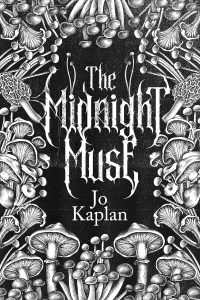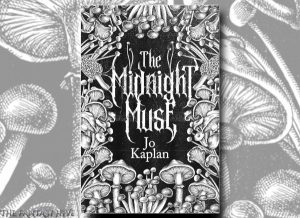THE MIDNIGHT MUSE by Jo Kaplan (BOOK REVIEW)
Tragedy Feeds the Soil in Jo Kaplan’s Midnight Muse
It’s easy to forget the creeping dread built into the most banal parts of being a person. Instead of being terrified of where our next paycheque comes from, where or how we’ll leave our mark in the world, of whether or not we matter in the lives of others, we instead categorise these fears as anxiety, for some reason. These are the worries, not fears; one of the biggest successes of anything truly scary is this duplicity. Don’t fear me, says the wolf; don’t fret, whispers the hungry shadow at the end of your bed. Instead, simply feel anxious. Anxiety lets fears dally in the day to day. We share rooms with the things that make us anxious, we go to work in a constant state of panic, and even at the most terrifying moments, at our worst straits, the anxiety is ingrained so deep that something as real as death seems immaterial next to something like, but who will pay the bills? One of the important things that any work of horror does, especially in the Weird space, is to reiterate how deeply terrifying something actually is. In Jo Kaplan’s Midnight Muse, these fears are those that anyone can relate to, anyone who knows what it’s like to want to be a rockstar, to want to be a writer, to want to be an artist, because of the money, because of the safety it affords—and because of the lasting legacy that we, somehow, will be around, even when we’re not. It’s a difficult process, and one that Kaplan does so well.
 Midnight Muse offers us a story any lover of music might feel an instant connection to. A band, a tragedy—and the horror of commercial art. The band, Queen Carrion, is headlined by Brynn, whose tragic disappearance haunts the novel, and haunts the bandmembers. After the band retreat to the woods for a creative break, Kaplan immerses us in that tenuous and tangible atmosphere of big personalities fighting over petty differences. The world may love strife in art—like how Fleetwood Mac famously all wrote songs about one another—but Kaplan gets to the real cost of when stories come at emotional, even physical prices. Brynn, the tortured-artist-insert whose very artistic vision embodies the band, is struggling to finish the album, and after going missing, other bandmembers, like Rhys and Jacqueline, attempt to usurp her role. It already sounds like a nightmare for anyone emotionally sensitive to snide remarks and awkward glances: but, as they’re all tripping on shrooms, they fail to recognise an insidious element lingering in the woods. The very shrooms they take for granted.
Midnight Muse offers us a story any lover of music might feel an instant connection to. A band, a tragedy—and the horror of commercial art. The band, Queen Carrion, is headlined by Brynn, whose tragic disappearance haunts the novel, and haunts the bandmembers. After the band retreat to the woods for a creative break, Kaplan immerses us in that tenuous and tangible atmosphere of big personalities fighting over petty differences. The world may love strife in art—like how Fleetwood Mac famously all wrote songs about one another—but Kaplan gets to the real cost of when stories come at emotional, even physical prices. Brynn, the tortured-artist-insert whose very artistic vision embodies the band, is struggling to finish the album, and after going missing, other bandmembers, like Rhys and Jacqueline, attempt to usurp her role. It already sounds like a nightmare for anyone emotionally sensitive to snide remarks and awkward glances: but, as they’re all tripping on shrooms, they fail to recognise an insidious element lingering in the woods. The very shrooms they take for granted.
Abound with doppelgangers, mistaken identities, buried regrets and success-chasing and supposed ‘artists’, Kaplan throws in the pernicious spread of spores and mycelium networks slowly leeching into each of the band. The nonhuman is not so much an evil, but something that operates as an illustration of how we as people project into the nonhuman. We forget that paper is dead wood, that computers are rocks that ‘think’—they themselves are not the epitome of all horror but are receptacles for our fears, and so fungi, as a lifeform built on networks and sacred geometries, feels like a fitting vehicle to really get to grips with how the characters in the novel end up meeting their grisly fates.
Splitting the narrative in two (before the event, and after), Kaplan guides the reader back and forth, not unlike how roots, how tangled networks themselves, operate. We seem to be outside of time, we as readers, and as the audience of Queen Carrion. Any readers of weird fiction or horror in the past twenty years will appreciate the mixed-media approaches Kaplan integrates. Reviews, articles, scientific reports mulch together with typical third person narratives and even journal entries. In the dirt, we are all the same stuff, and what we consume is also what consumes us. We consume a band in their entirety in reality, we know the tragedy of the 27 club, and we know the tragedy that befalls many who seek that tragedy in the first place.
Midnight Muse tries to reckon with a world where art is for entertainment. The commerce of entertainment, though; not the utopian ideal of scary stories round a campfire. Urban myths and folklores haunt this novel—even the beginning scenes take place in the woods, with the bandmembers sharing stories in the night, like all humans before them, in those nascent dwellings beneath a fecund cosmos of fire and fury. It’s easy to forget where the beauty of Van Gogh’s Starry Night comes from, after all, when he manages to render so beautifully the world that largely shamed and brutalised him in his tired, lonely nights in Arles. It’s easy to throw on Nirvana, to feel like Cobain speaks directly to us when he screams the chorus, Pain, pain, pain. Kaplan undoes that ease, Kaplan sticks and prods us with how horror stories—how art—comes about. Horror begets horror; pain begets pain. The real kernel of this novel is how Kaplan masterfully evokes the reader’s belief in a spectrum of characters who feel as real as the Wikipedia articles about our famous, beloved artists.
‘The dead collect in low places’, it’s a choral refrain for this novel, written by Brynn, repeated by Kaplan. Low places manifests in many different ways. The physical depth of the earth, moist and warm and ripe with mushrooms; the dimensional depth of reality, where energy levels aspire to be (come what may, upon the arrival of vacuum decay); and the emotional depth, the dead things of relationships, of people, their ghosts and ghouls and projections we taunt ourselves with. And are we a ‘low place’? Are we below the story? Are we what they find if they dig far enough, we who feed off the deadness of simulated life? Kaplan never says anything that lets you sit easily in a single answer. You’re meant to be afraid. Afraid that the story is the transmutation of real stories, and that, in turn, we realise every piece of fiction is just protracted reality, that nothing grows from nothing, that for fruit to bloom there must be rot feeding the roots. It’s like we’ve seen them all, like we’ve watched all the documentaries about what befell Queen Carrion in those woods, about what secrets were squashed, what otherworldly terrors were brushed aside for the plain banality of industry, of commerce in art. The story writhes in these tensions, and really works with the reader to approach some kind of solution in a world increasingly irresolvable. When you pick up Midnight Muse, remember that Kaplan’s words flesh out a universe beyond our understanding that we can only collapse into our perception—at least, hope that is the case, hope that nestled in these meanings are not little ideas desperate to live, to haunt, to grow.
The Midnight Muse is due for publication on 10th March 2026. You can pre-order your copy from Waterstones or Amazon

